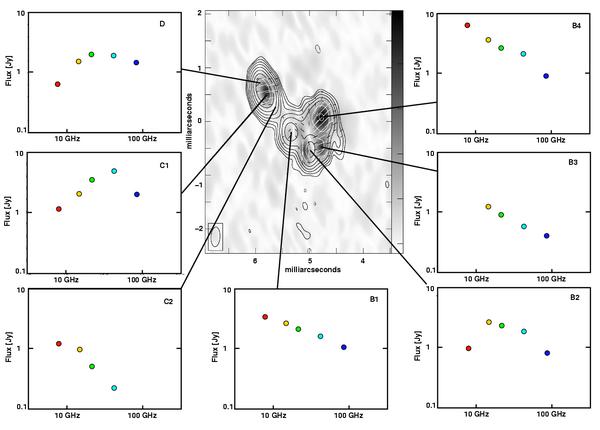

The montage below shows new detailed measurements of the core regions
of a so-called quasar, in this case one of the most famous, "3C273".
Quasars display some of the most amazing phenomena in astronomy, apparently
able to spit out truly huge amounts of energy from a central region no bigger
than the solar system. They are thought to be powered by black holes, which
may weigh as much as a billion times the Sun, into which gas and dust are
being dragged in dribs and drabs, resulting in spitting and sputterings in
the light as the gas is heated to enormous temperatures. The environment is
such that as much energy in X-rays and gamma rays are emitted by the gas as
in visible regions of the spectrum; in fact, it was the discovery of this
phenomenon in the early darks of X-ray and gamma-ray satellites in space,
which lead to our present ideas about quasars as physical systems.

Quasars invariably appear as very bright central points of light at most wavelengths, from radio to gamma rays. The glare from the central source may be so strong that detecting the background galaxy is a considerable challenge; nevertheless, researchers are interested to do so because the type of galaxy, and the environment in which it finds itself, are vital clues in tracking down the nature of these objects. Tuorla researchers have compiled many such detailed images of less fierce objects, termed "BL Lac galaxies".
In order to see the greatest details at the core of these very distant objects, special techniques are required. One of these is so-called VLBI, or Very Long Baseline Interferometry, in which the power of several widely seperated radio telescopes are combined in order to produce, using computers, a combined image of very much greater resolution than a single telescope could produce.
Now, Tuomas Savolainen, Esko Valtaoja and Kaj Wiik at Tuorla Observatory, have used VLBI techniques using the VLBA telescope array to obtain very detailed monitoring of goings-on in the core of the quasar 3C273.
The central part of the montage shows the radio image of 3C273 as it appeared in February 2003; the resolution of these images is remarkable — detail on the scale of milliarcseconds is seen. To get an idea of how small this is, an optical image of 3C273 is typically an arcsecond in size; the VLBI image has about 1000 times better resolution, and we are seeing details of what is happening within a few hundred light years of the core. This close, the core is seen to consist of several components; what we are likely seeing is cosmic sputtering — rather than a smooth outflow of hot gas from the very inner regions, where the black hole lies, the gas is being spat out in dribs and drabs.
The bursts seen here are at the very heart of the process which produces 3C273's spectacular jet, seen at many wavelengths and which extends to a few hundred thousand light years from the centre. Some spectacular images can be seen at the X-ray telescope Chandra's website.
The exciting aspect of the new data is that not only can the individual outbursts from the central black hole be monitored, the spectrum, or energy distribution of each can be measured as well. Spectra are shown for seven different blobs in the central image; they are quite different, some showing more energy at higher wavelengths while others show the opposite. Detailed studies of these preliminary spectra are underway, and promise to reveal much about the physical processes taking place in quasar cores.